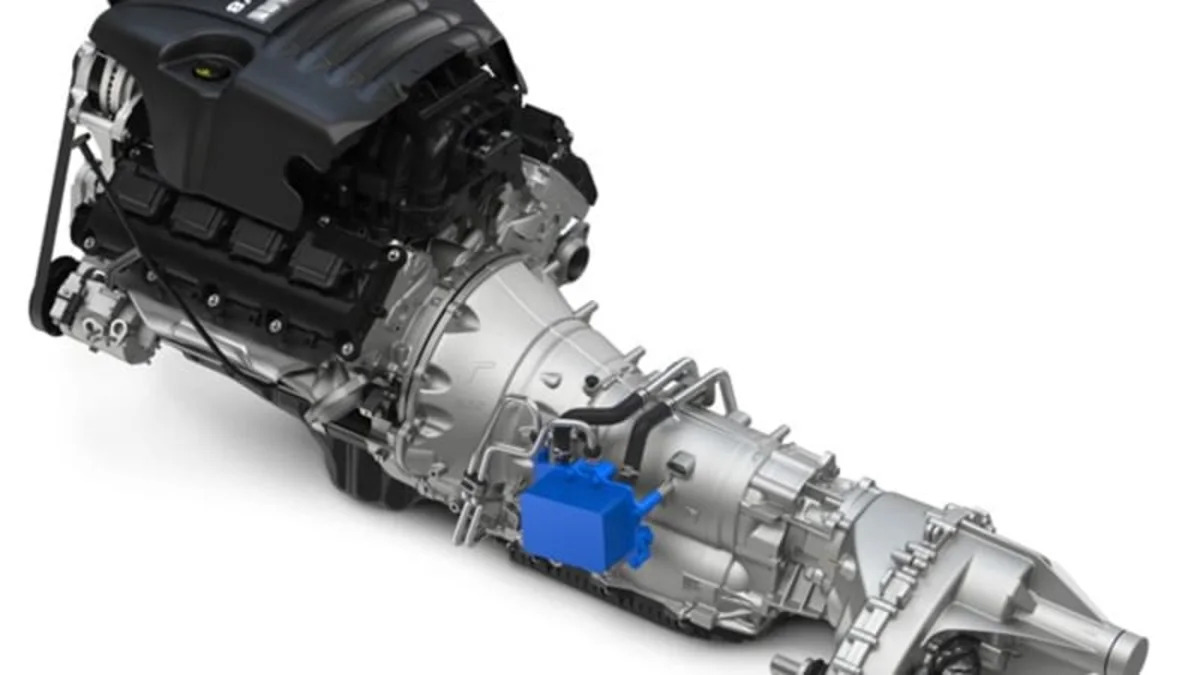Gasoline-powered, internal combustion engines are notoriously inefficient. Some estimates say as much as 70 percent of the fuel's energy is lost to friction and heat. An Automotive News story has engineers saying that only three percent is due to friction. To engineers, that's a huge pot of low-hanging, fuel-efficiency fruit.
Chrysler and Dana Holding Corp. have developed a "thermal management system" (highlighted in blue in the photo above) for the 2013 Dodge Ram that takes advantage of some of that heat. The truck's engine coolant is re-routed to bring the 2013 Dodge Ram's transmission to optimum operating temperature more quickly. When cold, honey-like transmission fluid drags on the powertrain. The sooner it warms up, the less fuel is wasted. The company claims the system improves fuel economy by two percent.
The system may be adapted for other Chrysler vehicles in the future. Similar systems from Dana are also being used on the Ford Edge where it adds about one percent to fuel economy.
Since a vehicle's engine also needs heat to operate efficiently, catalytic converter supplier Tenneco is working on a system that uses exhaust heat to warm the gooey transmission fluid.
For the future, though, Tenneco hopes to use waste heat to eliminate power-sucking alternators. The company is experimenting with thermocouple technology to convert heat directly into electricity. Current thermocouple hardware can convert one to three percent of exhaust heat into electricity. Tenneco says if it can improve that to as much as five percent, enough current can be generated to charge your car's battery with no drain on the engine. Standing in the way of thermocouple tech use on cars is its super high cost. The company hopes within six years to bring the price down 90 percent.
Chrysler and Dana Holding Corp. have developed a "thermal management system" (highlighted in blue in the photo above) for the 2013 Dodge Ram that takes advantage of some of that heat. The truck's engine coolant is re-routed to bring the 2013 Dodge Ram's transmission to optimum operating temperature more quickly. When cold, honey-like transmission fluid drags on the powertrain. The sooner it warms up, the less fuel is wasted. The company claims the system improves fuel economy by two percent.
The system may be adapted for other Chrysler vehicles in the future. Similar systems from Dana are also being used on the Ford Edge where it adds about one percent to fuel economy.
Since a vehicle's engine also needs heat to operate efficiently, catalytic converter supplier Tenneco is working on a system that uses exhaust heat to warm the gooey transmission fluid.
For the future, though, Tenneco hopes to use waste heat to eliminate power-sucking alternators. The company is experimenting with thermocouple technology to convert heat directly into electricity. Current thermocouple hardware can convert one to three percent of exhaust heat into electricity. Tenneco says if it can improve that to as much as five percent, enough current can be generated to charge your car's battery with no drain on the engine. Standing in the way of thermocouple tech use on cars is its super high cost. The company hopes within six years to bring the price down 90 percent.


Sign in to post
Please sign in to leave a comment.
Continue